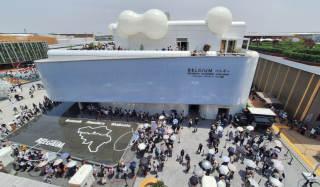To the south of the province of Luxembourg, right in the heart of Belgian Lorraine, the city of Arlon is well worth a detour. If you're a cycling enthusiast, you can't miss the Cycle Museum, a must-see spot to find out all about bicycles, while those who love hiking can enjoy heading out on one of the most beautiful long-distance hiking trails to be found, the Sentier de la Semois GR 16.
The Cycle Museum: discover the bicycle in all its forms
A spot that's entirely dedicated to bikes? A rare find! The Weyler Cycle Museum in Arlon is all the work of one man, a life-long lover of bicycles, Philippe Tibesar. Stepping through the doors of this unusual museum, you'll enter a den of bikes and discover everything there is to know about their history, from the very first wheels hitting the ground, right up to the latest developments. A collection boasting more than 250 pieces retraces the incredible yet little-known history of the bicycle. "I've got a balance bike, a pedal-powered velocipede (invented by Michaux in Paris in 1860), some old bicycles (from 1885)...," explains Philippe Tibesar, a man who never tires of discussing his favourite subject. "I've also got an indoor bike, or velocipede, from 1891. Incidentally, the same model could also be found on the Orient Express. They're exceptional pieces." The various items in the exhibition are grouped together by historical themes, from 1819 to modern-day pieces, racing bikes, different types of utility bikes, those with specific systems (shaft-driven, special derailers, etc.), children's bikes, and more. The museum also houses a collection of cycle tax plates from 1895 to 1991, a cycling-themed board game and around twenty mannequins dressed in period cycling outfits. A 20-minute film explains the various stages in the evolution of the bicycle. The tour is guided by the founder of the museum. He'll tell you all about the passion for bikes that he's held since he was a young child, and about this collection, patiently built up over many years.
Philippe Tibesar was also an amateur competitive cyclist. "I became immersed in the world of cycling when I was 14, and I still am to this day. I'm now 73 and I still cycle my 12,000 km every year." Although he hung up his competitive cycling shoes in 1976, he wasn't done with his love of bikes. For several decades, and with a group of fellow bike-loving friends, he set out on endless cycling tours across his beautiful region. Previously, he had also tackled the most formidable routes across Peru, Argentina, Vietnam, India, Italy, Corsica, and more. These excursions offered Tibesar many opportunities to meet other cyclists, which is how, one day in Switzerland, he came across another cycling fan who had founded a bicycle and motorbike museum. "Why can't that be me?" he wondered. This was the start of a long quest among scrap metal merchants, second-hand goods dealers, antiques dealers, and the like, carefully and patiently restoring each and every piece he found. The museum opened in 1992. Today, spread over 350 m² and seven exhibition halls, it presents a collection as big as it is varied: balance bikes, penny farthings, professional bikes, from all eras, for all purposes, from all over the world.
A visit to the Weyler Museum lasts roughly 1.5 hours and covers two centuries of history and cycling stories, told in minute detail and punctuated by several anecdotes – stories told by Philippe Tibesar himself, a passionate and fascinating guide. He devotes all his energy to these tours, sharing all his favourites with you. The Cycle Museum is open all year round, by appointment only. It really is a visit like no other, and well worth the trip.
The irresistible hiking trail, Le Sentier de la Semois GR 16
Feeling the need to stretch your legs and take a breath of fresh air? The Arlon region is perfectly located to quench your thirst for nature. Experience the feeling of pure bliss as your walk along the meanders of the Semois and discover a different landscape at every turn. In December 2022, the Walloon Government recognised the Semois Valley as a national park – and rightly so.
Follow the path of the Semois from its source to its confluence with the Meuse with the GR 16 Sentier de la Semois, one of Wallonia's most famous, and more recent, long-distance hiking trails, which was established in 2021 on the initiative of the non-profit association Les Sentiers de Grande Randonée (GR).
The GR 16 stretches over 200 km – 209 to be precise – from Arlon in Belgian Lorraine, passing through Gaume and all the way to Monthermé, in the French Ardennes, crossing the Belgian provinces of Luxembourg and Namur before ending up in the French Department of Ardennes. For the majority of the route, you'll find yourself crossing through nature parks, including Attert Valley, Gaume Natural Park and the Parc naturel de l'Ardenne méridionale in Belgium, as well as the Ardennes Regional Nature Park in France. The trail crosses the municipalities of Arlon, Attert, Etalle, Tintigny, Chiny, Florenville, Herbeumont, Bertrix, Bouillon and Vresse in Belgium, as well as Hautes-Rivières, Thilay, Tournavaux and Monthermé in France.
So, lace up your boots and let's go! The route starts from 71 Rue des Tanneris, in Arlon. We won't lie to you, this is a difficult trail, with a total elevation gain of over 4,400 metres. It's no mere after-dinner stroll. The markings are red and white, set at eye-level.
The trail often heads away from the Semois, but only to catch up with it again later. It may patiently weave along the river for a while, and then suddenly stray away from the banks to reach a ridge, where you can enjoy a breathtaking view over one or more of the river's many meanders. The official route cuts across the Semois 19 times, but there's nothing stopping you from crossing the river more often as you wish, thanks to the many bridges, gateways and fords.
The main attraction of this trail is undoubtedly the chance to discover several remarkable natural sites in quick succession. Nestled in its magnificent green surroundings, the route crosses legendary sites such as the Tombeau du Géant (Giant’s Tomb), the Echelles de Rochehaut (the Ladders of Rochehaut), the Roc La Tour and many others, not forgetting the different variations that allow walkers to choose a route along the riverbank or over the ridges. The Sentier de la Semois also offers numerous connections with other well-known trails, and shares several sections with the Transemoisienne, a route dedicated to walkers, horse-riders, carriage drivers and cyclists. What's more, walking along the GR 16 is also a great opportunity to discover the rich history of the regions it crosses, through the Roman, Medieval and contemporary periods. For those looking for a simple stroll along the Semois, there are several local walks all along the route. And when you need a well-earned rest, the region's guest houses and hotels will be happy to welcome you!
Par Jacqueline Remits







